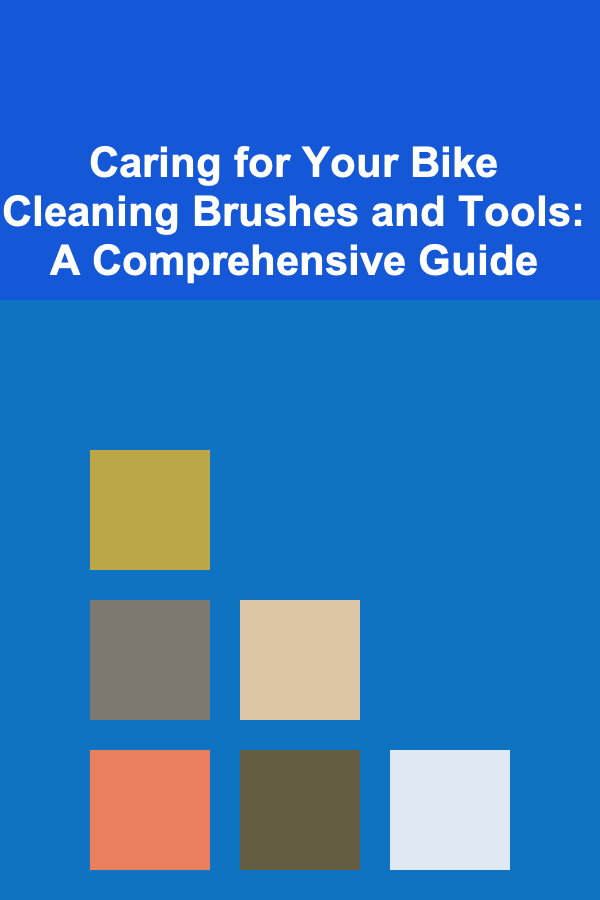
Caring for Your Bike Cleaning Brushes and Tools: A Comprehensive Guide
ebook include PDF & Audio bundle (Micro Guide)
$12.99$5.99
Limited Time Offer! Order within the next:

Maintaining a clean bicycle isn't just about aesthetics; it's a crucial aspect of extending its lifespan, improving its performance, and ensuring a safer riding experience. Dirt, grime, and road debris can accelerate wear and tear on vital components like the drivetrain, brakes, and suspension. However, the effectiveness of your bike cleaning routine heavily relies on the condition of your cleaning tools. Neglecting your brushes and tools can lead to transferring contaminants back onto your bike, rendering your cleaning efforts largely ineffective. This comprehensive guide will delve into the best practices for cleaning, maintaining, and storing your bike cleaning brushes and tools, ensuring they remain efficient and effective for years to come.
Why Proper Tool Maintenance Matters
Before diving into the specifics of cleaning and maintenance, it's crucial to understand why it's so important. Here's a breakdown of the key benefits:
- Preventing Cross-Contamination: Dirty brushes and tools can reintroduce grease, grime, and abrasive particles onto your bike. This defeats the purpose of cleaning and can actually worsen the situation by spreading contaminants to previously clean areas. Imagine cleaning your chain with a brush that's still coated in old, gritty grease. You're essentially just moving the problem around.
- Extending Tool Lifespan: Proper cleaning and storage significantly extend the lifespan of your brushes and tools. Residue buildup can cause bristles to become stiff and brittle, metal parts to corrode, and plastic components to degrade. Investing a little time in maintenance saves you money in the long run by reducing the need for frequent replacements.
- Maintaining Optimal Cleaning Performance: Clean brushes and tools are far more effective at removing dirt and grime. Stiff, clogged bristles struggle to reach into tight spaces and effectively agitate dirt, while a rusty chain cleaning tool will be less efficient and potentially damage your chain.
- Avoiding Damage to Your Bike: Using dirty or damaged tools can actually scratch or damage your bike's delicate surfaces, especially painted frames and sensitive components. A wire brush caked in grit can easily leave scratches, while a chain cleaning tool with a broken plastic guide can damage your chain.
- Promoting a More Enjoyable Cleaning Experience: Using clean and well-maintained tools makes the cleaning process more efficient and enjoyable. It's much more satisfying to work with tools that perform well and feel good in your hand.
Essential Bike Cleaning Tools and Brushes
Before we discuss cleaning techniques, let's identify the common tools and brushes used in bike cleaning. The tools you have will influence your cleaning methods.
- Soft Bristle Brushes: These are versatile brushes used for general cleaning of the frame, wheels, and other components. Look for brushes with synthetic bristles that are gentle on painted surfaces. Different sizes and shapes are useful for reaching different areas.
- Stiff Bristle Brushes: These brushes are designed for tackling stubborn dirt and grime, particularly on the drivetrain. They are effective for cleaning cassettes, chains, and derailleurs. Be cautious when using them on painted surfaces, as they can potentially cause scratches.
- Chain Cleaning Brush/Tool: Specialized tools designed to clean the chain quickly and effectively. These tools typically feature rotating brushes or scrubbing pads that remove grime from all sides of the chain. Some also include a reservoir for cleaning fluid.
- Cog/Cassette Brush: A long, thin brush designed to reach between the cogs of the cassette. The bristles are typically stiff and angled for effective cleaning.
- Wheel Cleaning Brush: A long, flexible brush specifically designed to clean the inside of the rims and spokes. The flexible design allows it to conform to the shape of the wheel.
- Detail Brushes: Small, fine-tipped brushes for cleaning hard-to-reach areas like brake calipers, cable guides, and suspension pivot points. Old toothbrushes can be repurposed for this task.
- Sponges and Microfiber Cloths: Used for wiping down surfaces and applying cleaning solutions. Microfiber cloths are particularly effective at removing dirt and grime without scratching the paint.
- Buckets: For holding clean water and cleaning solutions. It's helpful to have two buckets: one for soapy water and one for rinsing.
- Degreaser: A solvent used to dissolve grease and grime from the drivetrain. Choose a bike-specific degreaser that's safe for your bike's components.
- Bike Wash Soap: A mild soap specifically formulated for cleaning bicycles. Avoid using harsh detergents or household cleaners, as they can damage the paint and components.
Cleaning Your Brushes and Tools: Step-by-Step Guide
The cleaning process will vary slightly depending on the type of tool and the amount of grime buildup. Here's a general step-by-step guide:
Step 1: Initial Removal of Excess Debris
Before washing your brushes and tools, remove as much loose dirt and debris as possible. This can be done by:
- Tapping: Tap the brushes and tools against a hard surface (like the edge of a bucket) to dislodge loose dirt.
- Dry Brushing: Use a clean, dry brush to remove remaining loose particles.
- Compressed Air (Optional): If you have access to compressed air, use it to blow out dirt and grime from the bristles and crevices. Be sure to wear eye protection.
Step 2: Washing with Soap and Water
This is the primary cleaning step. Use warm water and a mild soap (dish soap works well, but bike-specific wash is preferred).
- Prepare Soapy Water: Fill a bucket with warm water and add a small amount of soap.
- Submerge and Agitate: Submerge the brushes and tools in the soapy water and agitate them to loosen dirt and grime. Use your fingers or another brush to scrub the bristles and surfaces.
- Focus on Heavily Soiled Areas: Pay particular attention to areas with significant grime buildup. For stubborn grease, you may need to use a stronger degreaser specifically designed for this purpose (see section below).
- Rinse Thoroughly: Rinse the brushes and tools thoroughly with clean water to remove all traces of soap. Hold them under running water until the water runs clear.
Step 3: Degreasing (for Tools Used on the Drivetrain)
Tools used on the drivetrain (chain cleaning tools, cassette brushes, stiff-bristled brushes) often require degreasing to remove stubborn grease and grime.
- Apply Degreaser: Apply a bike-specific degreaser to the affected areas of the tool. Follow the manufacturer's instructions for application and dwell time.
- Agitate and Scrub: Use a brush or sponge to agitate the degreaser and loosen the grease.
- Rinse Thoroughly: Rinse the tool thoroughly with clean water to remove all traces of degreaser. Ensure no degreaser residue remains, as it can damage your bike's components if transferred.
- Consider an Ultrasonic Cleaner (Optional): For deeply embedded grime, an ultrasonic cleaner can be highly effective. These devices use high-frequency sound waves to create cavitation bubbles that dislodge dirt and grease from even the most difficult-to-reach areas.
Step 4: Drying
Proper drying is essential to prevent rust and mildew growth.
- Shake Off Excess Water: Shake off as much excess water as possible from the brushes and tools.
- Air Dry: Allow the brushes and tools to air dry completely in a well-ventilated area. Avoid placing them in direct sunlight, as this can damage the bristles and plastic components.
- Hang Brushes Bristle-Down (Recommended): Hanging brushes bristle-down allows water to drain away from the ferrule (the part that holds the bristles in place), preventing water from accumulating and causing the bristles to loosen over time.
- Use a Clean Cloth (Optional): You can use a clean, dry cloth to wipe down metal parts to speed up the drying process and prevent rust.
Specific Tool Cleaning Recommendations
While the general cleaning steps apply to most tools, here are some specific recommendations for different types of bike cleaning equipment:
Chain Cleaning Tools
These tools require frequent cleaning due to the heavy grease buildup they encounter. Disassemble the tool after each use (if possible) and clean each component thoroughly. Pay particular attention to the brushes or scrubbing pads, ensuring all grease and grime are removed. Degreasing is essential for these tools.
Cassette Brushes
The long, thin design of cassette brushes makes them difficult to clean thoroughly. Use a strong degreaser and a small brush to clean between the bristles. Consider using compressed air to blow out any remaining debris. Inspect the bristles regularly and replace the brush if they become bent or worn.
Wheel Cleaning Brushes
These brushes are often exposed to road grime and brake dust. Rinse them thoroughly after each use and use a degreaser to remove any stubborn brake dust. Check the brush head for wear and tear, and replace it if necessary.
Soft and Stiff Bristle Brushes
These brushes are relatively easy to clean. Rinse them thoroughly after each use and allow them to air dry completely. Inspect the bristles regularly and replace the brush if they become bent, worn, or clogged with dirt.
Sponges and Microfiber Cloths
Sponges and microfiber cloths can be washed in a washing machine. Use a mild detergent and avoid using fabric softeners, as they can reduce the absorbency of the microfiber cloths. Air dry or tumble dry on low heat.
Storage Best Practices
Proper storage is just as important as cleaning when it comes to maintaining your bike cleaning brushes and tools.
- Store in a Dry Place: Store your brushes and tools in a dry place to prevent rust and mildew growth. Avoid storing them in damp or humid environments.
- Hang Brushes Bristle-Down: As mentioned earlier, hanging brushes bristle-down is the best way to prevent water from accumulating in the ferrule and loosening the bristles.
- Organize Your Tools: Store your tools in an organized manner to prevent them from being damaged or lost. A tool box or pegboard is a good option for storing your tools.
- Protect from Dust and Debris: Cover your tools with a cloth or store them in a container to protect them from dust and debris.
- Separate Clean and Dirty Tools: Consider having separate storage for cleaned tools vs. tools waiting to be cleaned to prevent cross contamination.
Addressing Common Problems
Despite your best efforts, you may encounter some common problems with your bike cleaning brushes and tools. Here's how to address them:
- Stiff Bristles: If the bristles on your brushes become stiff and brittle, try soaking them in warm water with a small amount of fabric softener. This can help to restore their flexibility. If the bristles are permanently damaged, it's time to replace the brush.
- Rusty Tools: If your metal tools develop rust, use a wire brush or steel wool to remove the rust. Apply a rust preventative to protect them from further corrosion. Consider using a penetrating oil like WD-40 to loosen stubborn rust.
- Mold or Mildew: If your brushes or tools develop mold or mildew, wash them with a solution of bleach and water (1 part bleach to 10 parts water). Rinse them thoroughly and allow them to air dry completely in a well-ventilated area.
- Broken or Damaged Tools: If your tools are broken or damaged, replace them immediately. Using damaged tools can be dangerous and can also damage your bike.
- Persistent Grime: For tools used on the drivetrain with baked-on grease, try using a citrus-based degreaser. These are often more effective than traditional degreasers for heavy grime. Let the degreaser soak for an extended period before scrubbing.
Choosing the Right Cleaning Products
Selecting the appropriate cleaning products is crucial for both the longevity of your bike and the effectiveness of your cleaning routine.
- Bike-Specific Cleaning Solutions: Opt for cleaning solutions specifically designed for bicycles. These are formulated to be gentle on paint, delicate components, and various materials used in bike construction.
- Biodegradable Options: Consider using biodegradable cleaning products to minimize your environmental impact.
- Avoid Harsh Chemicals: Avoid using harsh chemicals like bleach, ammonia, or strong solvents, as these can damage your bike's components and paint.
- Degreaser Selection: Choose a degreaser appropriate for your needs. For light cleaning, a water-based degreaser may suffice. For heavy-duty cleaning, a solvent-based degreaser may be necessary. Always follow the manufacturer's instructions when using degreasers.
- Lubricants and Protectants: After cleaning, consider applying lubricants and protectants to key components like the chain, cables, and pivot points. This will help to keep your bike running smoothly and prevent corrosion.
The Importance of Regular Inspections
Make it a habit to regularly inspect your bike cleaning brushes and tools for signs of wear and tear. This will help you identify potential problems before they become major issues.
- Check Bristles: Inspect the bristles on your brushes for bent, broken, or worn bristles. Replace the brush if the bristles are no longer effective.
- Examine Tool Heads: Check the heads of your tools for damage or wear. Replace the tool if the head is cracked, broken, or loose.
- Inspect Handles: Check the handles of your tools for cracks, breaks, or looseness. Replace the tool if the handle is damaged.
- Look for Rust and Corrosion: Inspect metal tools for rust and corrosion. Remove any rust and apply a rust preventative.
- Assess Overall Condition: Take a general look at the overall condition of your tools. If they are showing signs of significant wear and tear, it's time to replace them.
Beyond Cleaning: Extending Tool Life
While cleaning is paramount, certain practices can further prolong the lifespan of your cleaning tools.
- Dedicated Tool Sets: Consider having separate sets of brushes and tools for different tasks. For example, one set exclusively for the drivetrain and another for the frame and wheels. This minimizes cross-contamination and reduces the overall wear on each set.
- Avoid Over-Aggressive Scrubbing: While effective cleaning requires some scrubbing, avoid excessive force, which can damage bristles and tool components. Let the cleaning solution do its work and use moderate pressure.
- Immediate Attention to Spills: If you accidentally spill degreaser or other harsh chemicals on your tools, clean them immediately to prevent damage or degradation of materials.
- Regular Lubrication (for Moving Parts): Some chain cleaning tools and other specialized tools have moving parts. Periodically lubricating these parts with a light oil or grease will ensure smooth operation and prevent premature wear.
- Know When to Replace: Despite your best efforts, tools eventually wear out. Don't hesitate to replace a tool that is no longer performing optimally. Continuing to use a worn-out tool can be less effective and potentially damage your bike.
By following these guidelines, you can ensure that your bike cleaning brushes and tools remain in excellent condition, allowing you to maintain your bicycle effectively and extend its lifespan. Remember that consistent maintenance is key to both a clean bike and long-lasting tools. A well-maintained bike and cleaning kit will provide you with years of enjoyable and safe riding.

How to Choose the Perfect Playlist for Your Party's Vibe
Read More
How to Display Artwork and Decor Alongside Your Books
Read More
How to Make a Checklist for Event Promotion Budgeting and Cost Management
Read More
How To Research the Battle of Cannae
Read More
How to Set Up a Checklist for Effective Stakeholder Communication
Read More
How to Combat Overcommitment and Burnout
Read MoreOther Products

How to Choose the Perfect Playlist for Your Party's Vibe
Read More
How to Display Artwork and Decor Alongside Your Books
Read More
How to Make a Checklist for Event Promotion Budgeting and Cost Management
Read More
How To Research the Battle of Cannae
Read More
How to Set Up a Checklist for Effective Stakeholder Communication
Read More